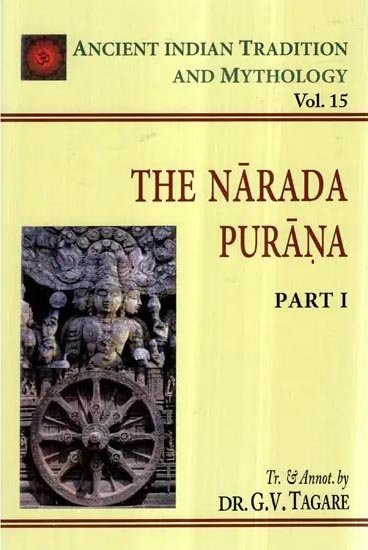Narada Purana (English translation)
by G. V. Tagare | 1950 | 14,468 words | ISBN-10: 8120803477 | ISBN-13: 9788120803473
This page describes Preface to First Volume of the English translation of the Narada Purana—an ancient Sanskrit text within Hindu literature categorized as one of the eighteen Mahapuranas. It explores various aspects of cosmology, ethics, and rituals, compiling rich narratives that emphasize devotion to Vishnu and the concepts of Dharma (righteousness) and Bhakti (devotion). The Narada Purana also addresses Tantric practices, philosophical discourses on Yoga and self-realization.
Preface to First Volume
The present volume contains the Nārada Purāṇa Part I (Chapters 1-41 completing the first Pāḍa in English translation). This is the fifteenth volume in the series of fifty volumes, which we have planned on Ancient Indian Tradition and Mythology.
The project of the series was envisaged and financed in 1970 by late Lala Sundarlal Jain of Messrs Motilal Banarsidass. Hitherto fifteen volumes of the series, including the present one (that is, four volumes of the Śiva Purāṇa, two volumes of the Liṅga Purāṇa, five volumes of the Bhāgavata Purāṇa, three volumes of the Garuḍa Purāṇa and the present volume of the Nārada Purāṇa) have been published and released for sale.
The present volume, like all other volumes, is encyclopaedic in character. It deals with miscellaneous topics such as religion, philosophy, Veda and its ancillaries—Śikṣā, Kalpa, Vyākaraṇa, Nirukta, Chandas and Jyotiṣa. In Śikṣā it describes the rules of pronunciation of Vedic and Classical Sanskrit and the rules regarding music. In Kalpa it deals with the Nakṣatra, Veda, Saṃhitā, Āṅgirasa and Śānti kalpas. In Vyākaraṇa, it gives a general idea of the subject. In Chandas it prescribes rules for Sanskrit and Prākṛta, Vedic and Classical metres by the method of Prastāra. In Jyotiṣa it explains the essentials in detail. While dealing with the Purāṇas, it describes the contents of the Purāṇas which help us to ascertain the interpolations of the later period. Among the general topics, it describes Vratas and Tīrthas in details and exhaustively.
In the Sectarian grouping of the Purāṇas, the Nārada Purāṇa is classified as a Vaiṣṇava Purāṇa on the basis of the fact that among the deities glorified in this Purāṇa, Viṣṇu holds the supreme position, though laudatory references to other deities—Śiva, Śakti, etc. are also made. In his obvious partiality for Vaiṣṇavism, Nārada gives special treatment to Rādhā and Kṛṣṇa, even prescribes a hymn of 1000 names in their eulogy and proclaims special importance of Ekādaśī Vrata in honour of Viṣṇu. He is the first to mention Rāma, Kṛṣṇa, Nṛsiṃha and other incarnations in connection with Tantric practices.
The variety of topics is very interesting but it is marred as sometimes it is couched in expression that needs elucidation—a task which could not be accomplished by a mere translation. Hence, a provision has been made for the notes, which are attached to each chapter, separately, and not put at the foot of a page as has been the practice hitherto. We hope the reader will not feel embarrassed by this shift.
The translation is based on the Sanskrit text of the Nārada Purāṇa published by Messrs Kṣemarāja Śrīkṛṣṇadāsa, Veṅkaṭeśvara Press, Bombay. This text, constructed on the collation of manuscripts and supported by the evidence of citations found in the Smṛti granthas, is fairly accurate.
We have included abbreviations in this part and they will be repeated in successive parts with such additions as are inserted in the notes in those parts. The Glossary and the General Index to the complete Purāṇa will be appended to the last part.
Acknowledgment of obligation
It is our pleasant duty to put on record our sincere thanks to Dr. R. N. Danḍekar and the authorities of the UNESCO for their kind encouragement and valuable help which render this work more useful than it would otherwise have been. We are extremely grateful to Dr. Tagare who in the storm and stress of his pressing occupations has snatched time for this national work. The exhaustive Introduction, the lucid translation and explanatory notes are, in fact, monumental contributions in the field of Inḍology. We must also thank Shri T. V. Parameshwar Iyer for his valuable assistance in the preparation of Translation, and express our gratitude to all those who offered suggestions for improving the same.
—Editor
